Earlier this month, I decided to leave my parsley plant to the mercy of the Black Swallowtail caterpillars that were devouring it at an alarming rate. The early larval stages (termed instars) molt several times, changing their appearance more or less dramatically between molts. The earliest instars are dark and have a white saddle, making them look very much like bird droppings.
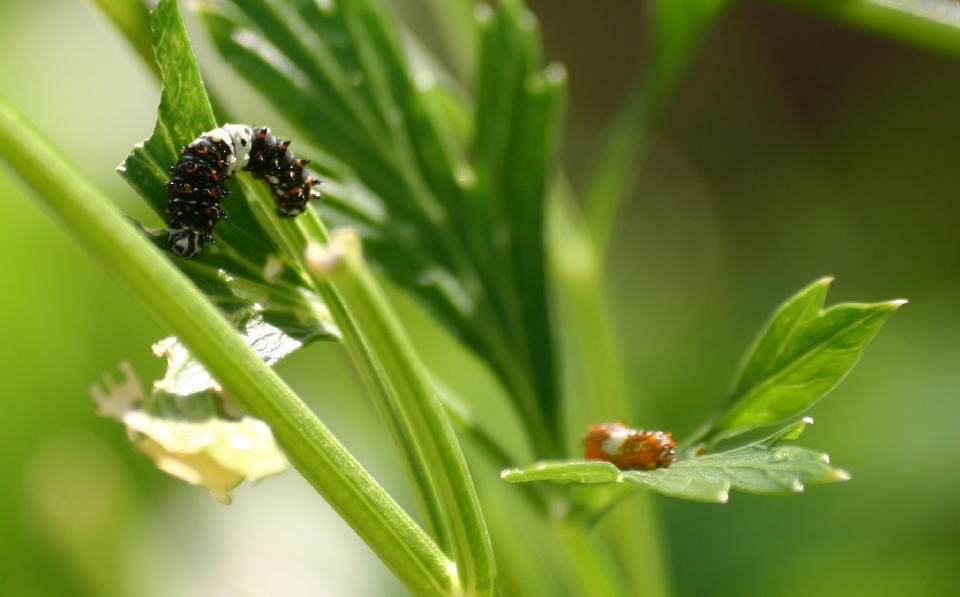
Two early instars (Click for full screen view)
Some of the earliest instars, somewhat tan in color, were only about 4 millimeters long. This one was about 11 millimeters:
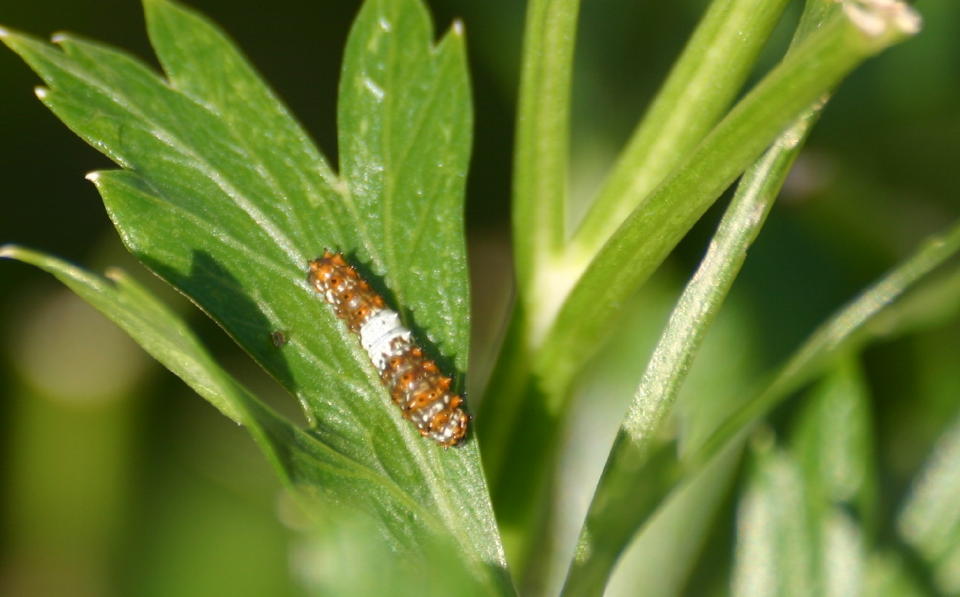
Very early instar (Click for full screen view)
This one was older and darker, measuring approximately 16 millimeters:
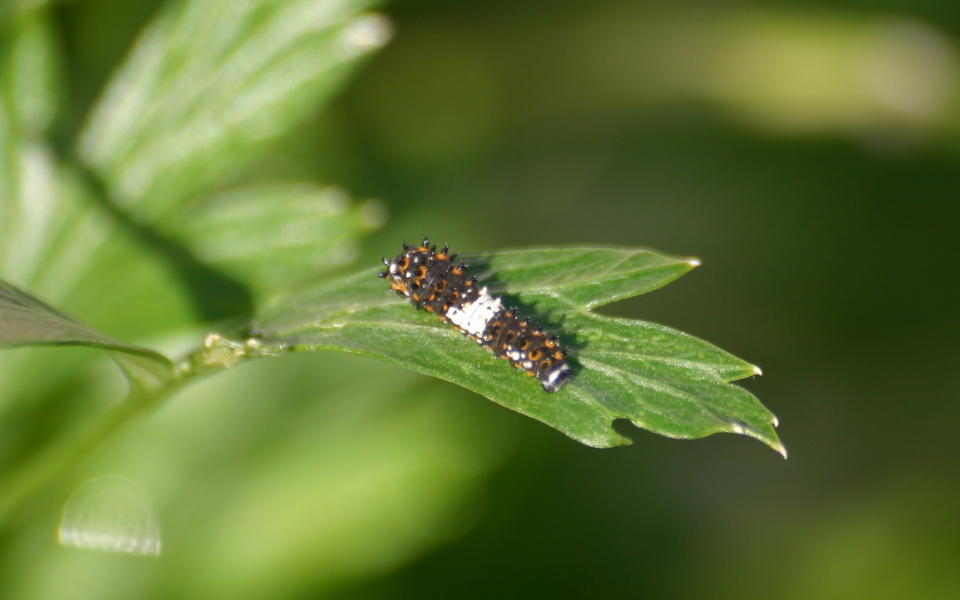
Early Instar (Click for full screen view)
After another molt, about two days later, this caterpillar retained some of the white saddle.It measured about 2 cm.
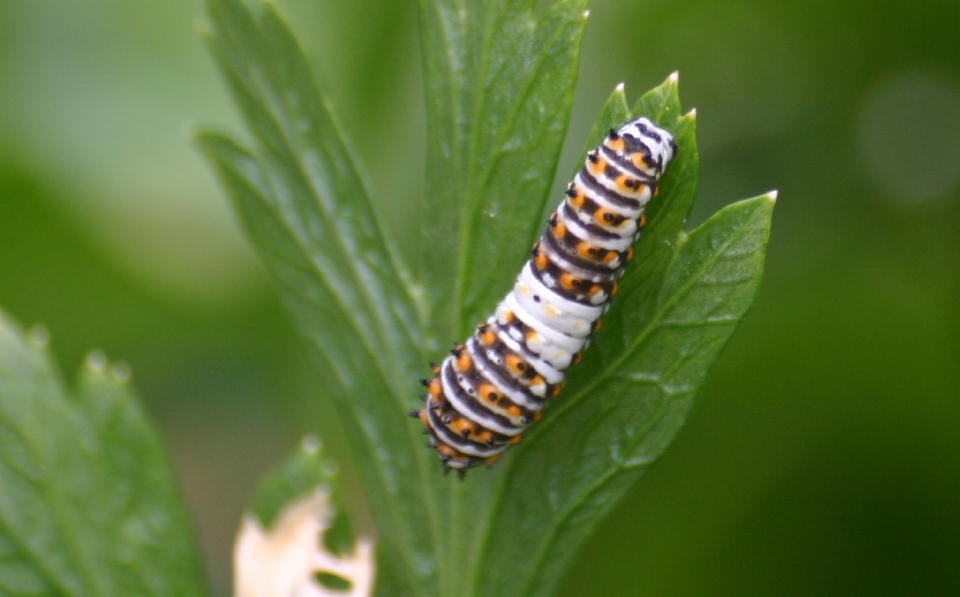
Intermediate Instar (Click for full screen view)
When I first discovered the infestation, there were several caterpillars in more advanced stages. I decided to watch them to see if I could find a chrysalis. One by one, they disappeared , and hard as I tried, I could not find any among the parsley or nearby plants.
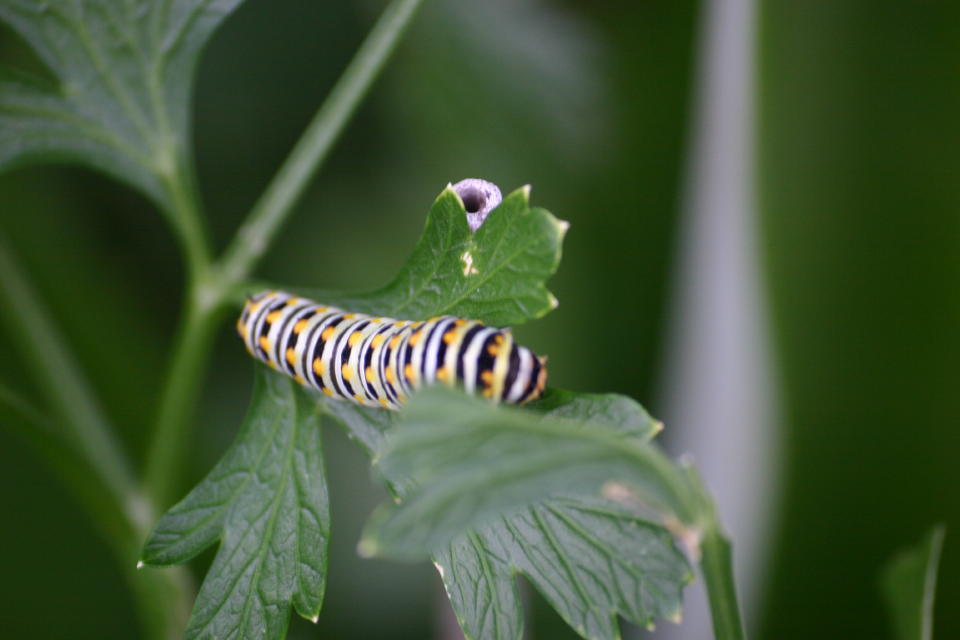
July 8 Later Stage Instar (Click for full screen view)
When there were only two left, I collected this one and brought him into the kitchen on a generous sprig of parsley, hoping to watch it pupate.
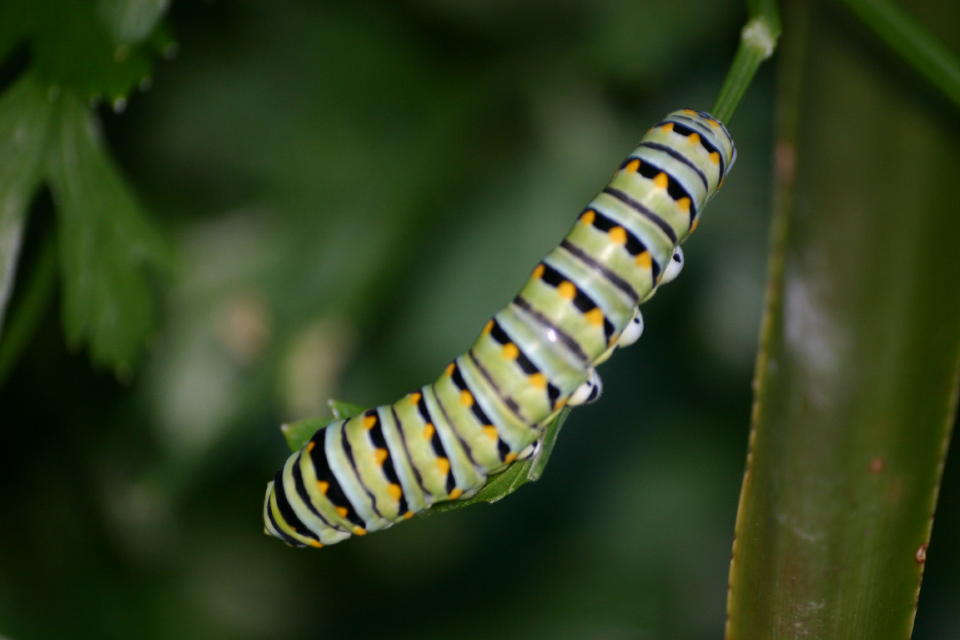
July 10 Late Stage Instar (Click for full screen view)
The caterpillar was truly an eating machine, devouring entire parsley leaves in a couple of minutes and depositing large amounts of feces. Its head area began to swell noticeably. Then, on the third day of captivity, it stopped eating and assumed this crooked position, remaining immobile for the entire day. Note the strand of silk that it had spun as a kind of sling that will help support it as a chrysalis.
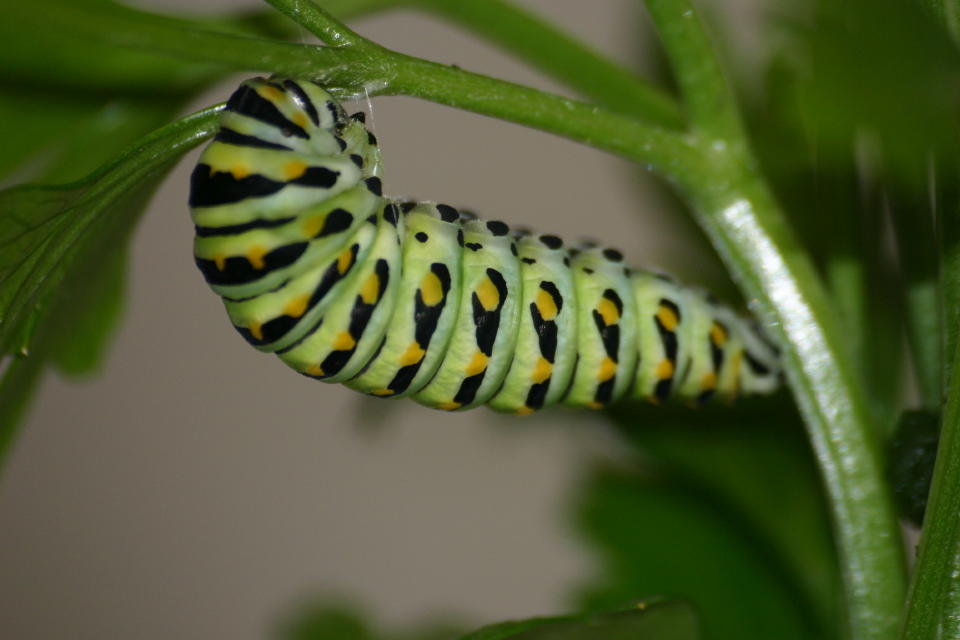
July 13 Nearing pupal stage (Click for full screen view)
I hoped to see it actually morph into the chrysalis, but it looked about the same when I went to bed at 11 PM. The next morning, I first thought it had escaped, as it was nowhere to be seen. I was amazed how the new chrysalis blended into the parsley leaves. Its newly cast off skin was just underneath it.
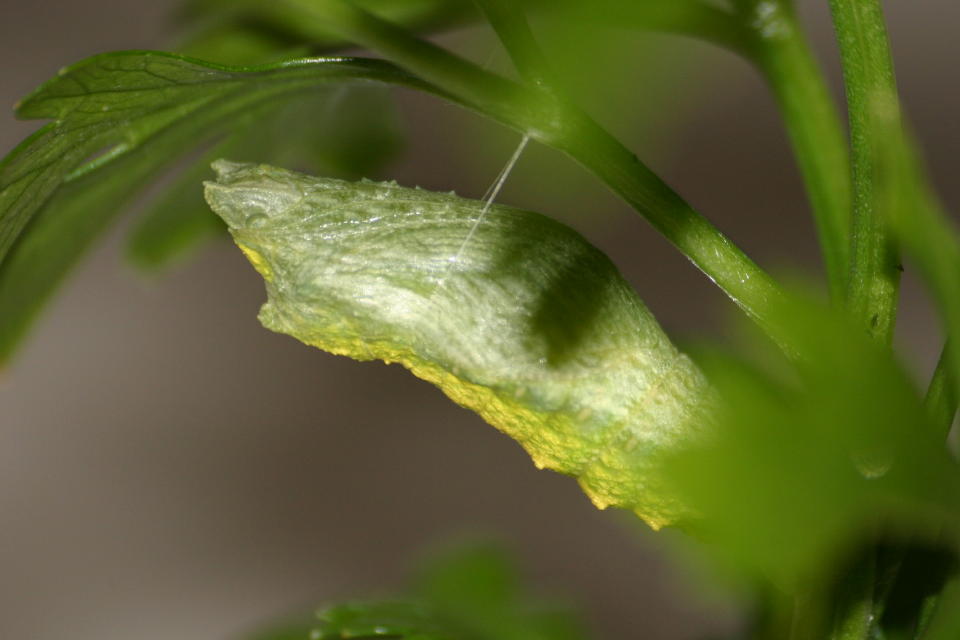
July 14 New Chrysalis (Click for full screen view)
The protuberance under its head seemed to grow a bit by the next day, but its color and appearance were otherwise unchanged.
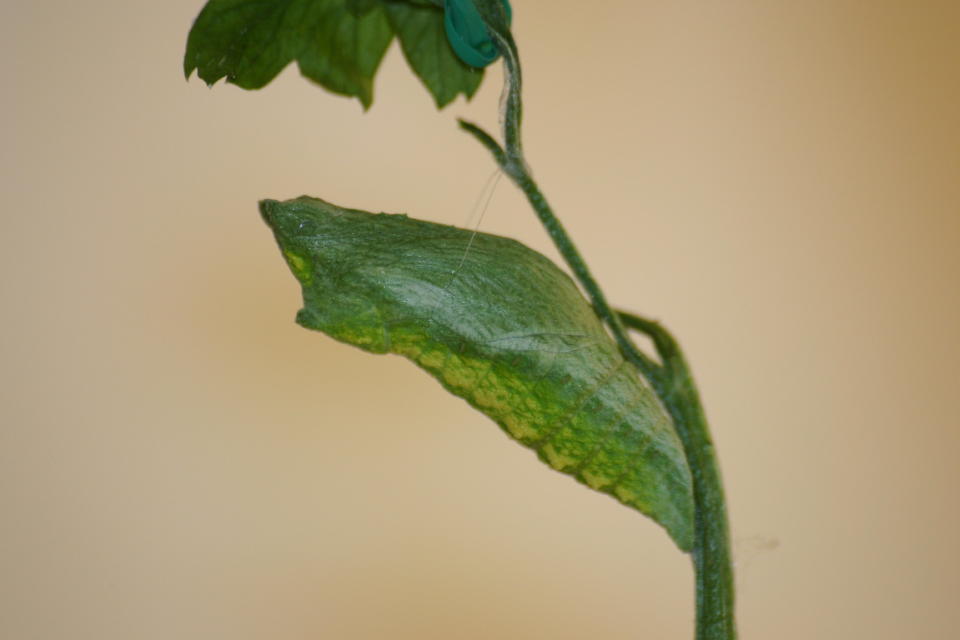
July 15 Second-day Chrysalis (Click for full screen view)
At about the one week point, the dark body of the butterfly inside the chrysalis became more apparent.On the ninth day, the wing spots were visible and we knew the butterfly was ready to emerge. We watched the British Open on TV, but did check a couple of times.
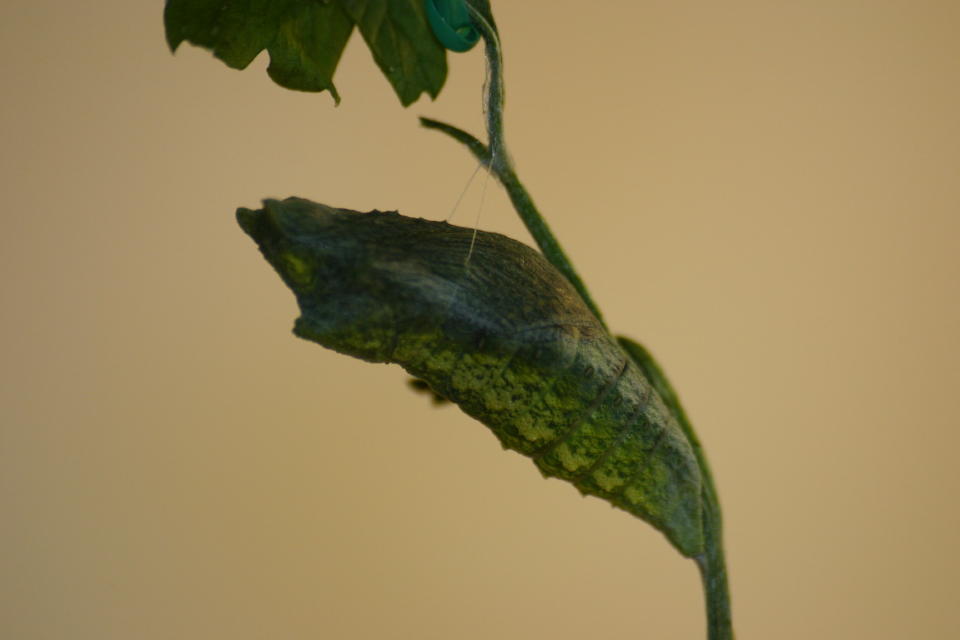
July 22 9:18 AM, Ninth Day, Chrysalis, 7 hours before emerging (Click for full screen view)
Just after 2 PM, the chrysalis appeared to be intact, but even more swollen and quite dark. Note the spots on the butterfly’s abdomen showing through the pupal case:
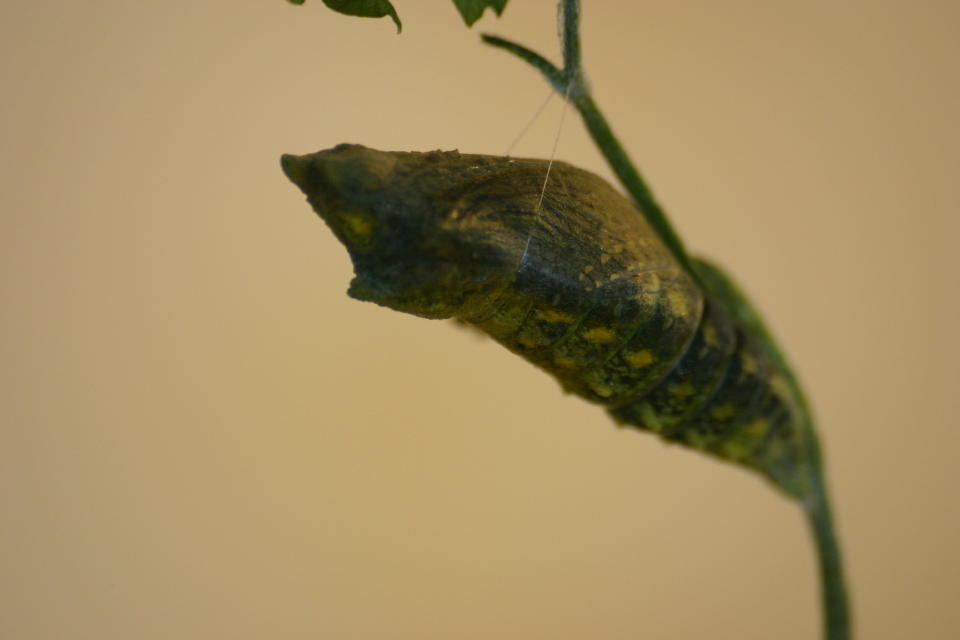
July 22, 2:19 PM, 2 hours before emerging (Click for full screen view)
The British Open had a thrilling finish, and we forgot to check it until just after 4 PM, when we were greeted by the newly emerged butterfly, clinging to the empty chrysalis. Note how swollen the abdomen appears. It began to thin out as the insect pumped fluid into its wing veins:
: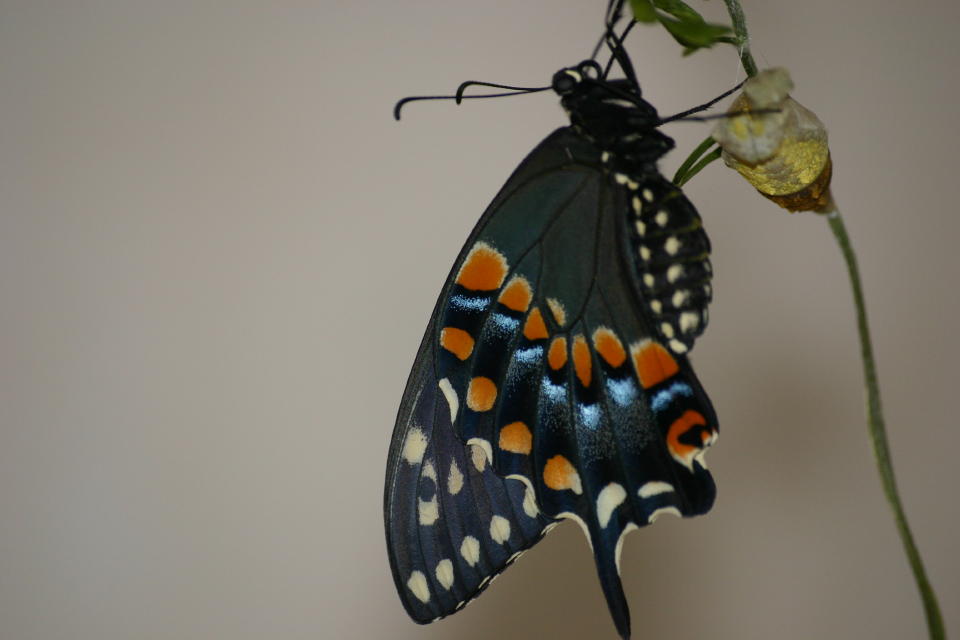
July 22 - 4:14 PM Wings expanding (Click for full screen view)
The Black Swallowtail had emerged. We brought it outside and I took a final photo. It flew away a few minutes later.
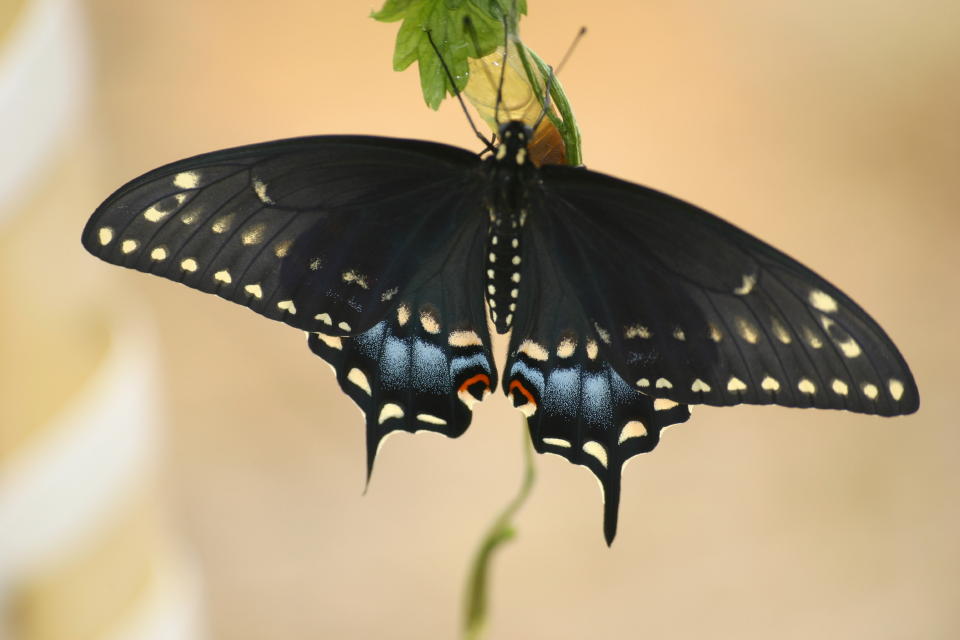
httJuly 22 - 5:28 PM Our last look (Click for full screen view)
The row of yellow spots on the margin of the forewing and the blue band on the hindwing identify this as a female. To find out more about the life history of this butterfly, see Black Swallowtail species description in the Texas A&M Field Guide, and this excellent guide from Montana State University.













July 22nd, 2007 at 9:03 am Hello, I too have many, about 9 or 10 of these little caterpillars and I was wodering if you could give me any advice on keeping them in captivity. They do love Parsley!
July 22nd, 2007 at 10:34 am Kira, thanks for your post. What I did was to cut a generous clump of parsley stalks and tie them into a bundle. Then I put them with some water in a plastic sandwich bag, secured it with a rubber band. After transferring the caterpillar to the parsley, I set the bag on some paper towels, put a big plastic (pickle) jar over it all. The jar helped support the stalks and the water did not evaporate as fast as if I had tried to put the stems in a jar. My caterpillar turned into a chrysalis quite rapidly, so I did not need to add more water or new parsley. If you wait until the caterpillars get quite large (about 1 1/2 inch long, or when their head ends appear to be swelling up) before capturing them you will probably have the same luck. After the chrysalis formed, I trimmed the parsley leaves and suspended the stalk from a kitchen banana stand using a twist tie. An alternative would be to use a small commercially available lizard/bug aquarium (actually a terrarium or vivarium) that has clear plastic sides and a ventilated top for keeping both the larvae and the chrysalises. I have also seen one with the host plant in a 4 inch flower pot (some supermarkets sell parsley this way in the vegetable section), then with a sleeve made of an upside-down plastic jar with its bottom cut off (or a 2-liter soda bottle with to and bottom cut off to make a tube), to keep the caterpillars from wandering off the potted plant. The whole thing can then be put inside a larger clear plastic bag with a twist-tie at the top which can be opened to provide fresh air. Hope this helps!
July 22nd, 2007 at 9:55 pm Fascinating series of photos! Thanks for sharing them. I had some of the smae cats on my parsley plants, but they disappeared before I had the chance to kidnap them so that I could witness their transformation. How many days was it from the time it made the chrysalis?
July 23rd, 2007 at 6:06 am The butterfly emerged about 8 1/2 days after the chrysalis formed. My search on the Internet suggests that this can be variable. My observations here in Florida may not transfer to other parts of the country. The Black Swallowtail survives the winter in this stage, so it can be a matter of 4 or 5 months. Perhaps temperature or length of days somehow influence this. I will collect more caterpillars from this next cycle and report on what happens.
August 19th, 2007 at 7:41 am Great series of photos here… I have been raising butterflies for years, but have never been able to quite capture shots like those. What camera and lens do you use? Thanks. J
August 20th, 2007 at 8:15 am Thanks, Jack– My more recent photos (since early this year) were taken with a 6.5 megapixel Canon Digital Rebel EOS with a Sigma 70-300 mm zoom lens. For the close-ups I used the Macro setting at 300 mm. I used manual focus with automatic exposure at portrait setting. Automatic flash kicked in on some. All handheld except for the caterpillar shots, when I used a tripod (which immensely increased the percentage of usable photos). Before that, I used a point and shoot Canon A40 with the home-made digiscopic setup, using my Kowa 80mm spotting scope, described at this link: http://rosyfinch.com/photos.html#Kens_Digiscopic The Rebel was a gift from my son-in-law, who gave it to me after he upgraded to an EOS 30. I bought the Sigma lens for only $200 and so far it has performed very well. Ken
October 27th, 2007 at 9:15 pm Found you via Stumble and just love your shots! This is a wonderful series of pictures of the Black Swallowtail! Keep up the great work!
November 5th, 2007 at 11:52 am the idea of taking shots of the whole process was great!
August 17th, 2008 at 2:51 pm I’ve brought into my screened-in porch a large pot of fennel on which I counted 17 black swallowtail caterpillars. They seem quite content ravishing the fennel and some have grown and completed a couple of instars. A few have swollen heads and, I believe are ready to spin their chrysalis’. The problem is, it’s August 17th. I don’t know if they will survive a Kansas winter or if they’re going to complete the life cycle and become butterflies in September. That might be a bad thing if cold weather comes early this year. If anyone is monitoring this site and wants to respond I’d appreciate some input. I’m rooting for these guys with my whole heart and am giving them everything they need (including parsley to supplement their diet!) Keep your prayers with me and my new family. Cindy
August 17th, 2008 at 8:59 pm Hi, Cindy, Our Florida experience may not be transferable to your situation in Kansas. I believe that they may undergo two generations in temperate climates, and three in Florida. Although they usually seem to rely upon overwintering as a chrysalis, they are also known to overwinter in the adult form. If your butterfly does not emerge after 10 days to 2 weeks, it may overwinter in the pupal stage. To do this, it should be kept in a cool place, such as a wooden box with ventilation. They also should be misted with water a couple of times a week, if not exposed to the elements. Even in Florida, the Black Swallowtail attacks our parsley rather late in the season, around early July. I am guessing that yours will emerge and have time to breed one more time. We are now in Illinois, and wild carrots/Queen Anne’s Lace is abundant. They should stay green for a few more weeks. The caterpillars grow amazingly fast. One of my chrysalises that I took to Illinois failed to emerge, and it dried out and died, perhaps because I failed to mist it, or maybe because I kept it inside after the others had emerged. Maybe other readers will share their experiences. Good luck! Ken
October 7th, 2009 at 3:12 pm i have about 8 chrysalises and not one has come out. they have been like that for over 2 weeks and are not turning any darker. i don’t know if they are dead or not. i heard something about keeping it humid, but i don’t know how to do that. how do you make the come out? PLEASE HELP!
October 20th, 2009 at 8:14 pm Thanks. i sprayed them with water and put them outside. i live in the south west so it was still pretty warm. it rained for a while and i for got to check on them because i was so busy. about a week later i went to check on them and these two big red bodied double black winged bugs where ther. they did not look like butterflies at all. then i looked at the chrysalises, and they all had a centemeter sized hole and they where empty. they all were like that except one. and i thought it was saved. but it wasn’t moving and i was worried. plusd it was leaking something, so i knew it was dead. i thought it would be a good learning experiance to see what they looked like while they developed. but when i opened the chrysalis the same bug was coming out of it. i know for sure it was not a butterfly. it had the body and head of an ant. but it was not an ant. i killed it and i was so upset. i am sad that i could not use your advice even if it isn’t an expert one. maybe you can tell me what i did wrong. or maybe even what the bug was?
October 24th, 2009 at 7:18 am Hi, Cristina,
While I am no expert on the subject, it is possible that either you collected a non-butterfly pupa, or a parasitic creature such as a fly or wasp deposited its eggs on the caterpillar or pupa, and its own progeny emerged after feasting on the butterfly.
Without seeing the insect, or having a detailed description, it would be impossible for me to identify the creature that did emerge. What many people do (besides ordering caterpillars or a chrysalis from suppliers) is to capture caterpillars on host plants when they are close to maturity, then continue to feed them the same plant until they form a chrysalis.
Popular host plants are milkweed (for Monarch Butterflies) and parsley (or other members of the family such as carrots and Queen Ann’s Lace) for Black Swallowtails. I used the latter approach– putting them in a container with a screened top and adding fresh sprigs of parsley (with a small plastic bag with some water, secured to the stems with a rubber band) every day or so. They grow quite rapidly. I found it very hard to even find their chrysalises in the parsley in my garden, as they are very well camouflaged and blend in with the color of the stems.
Thanks so much for relating your interesting experience, and good luck in the spring! Ken